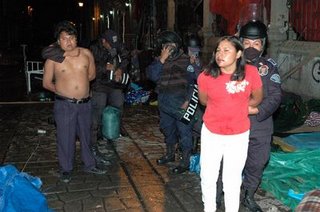Oaxaca, Mexico
It was the pungent smell of enclosed human activity sustained over a period of weeks, rather than the empirical details that I should have been taking note of, that I remember most clearly. The demographics of the demonstration, the strategy employed in blocking the roads, the intensification of police presence, unfortunately went unnoticed as I skirted around sleeping bags laid down on the flagstones, under the blue tarps strung from lamppost to balcony, which the smoke from makeshift kitchens caused to swell. Why I remained unfazed by this extraordinary obstruction between myself and the market was that from the toddlers on a mat draped over the sidewalk, to the men clustered around a radio, to a woman chopping vegetables in the back of a truck, was the atmosphere of sheer normality. The participants seemed to have been suddenly transported from their private homes into the public square and were continuing the tasks that they had previously been engaged in. Other than being out in the open it was not out of the ordinary.
This year, however, the strike of the Oaxacan teachers ended in calamity. In the early hours of June 14, teachers from the National Education Workers Union (SNTE) who had been camping in the historic centre of the city were violently awakened by over 1700 police. They were dragged from their tents and dozens of canisters of tear gas fell from the helicopters above. The strikers who participated in the urban warfare that ensued had only objects found in the street to use for defense; from the number of children and at-risk individuals caught in the melee, clearly nobody had expected violence. Four people were killed and at least 92 were injured, including a pregnant teacher who miscarried due to tear gas toxins.

For more than 25 years, the SNTE has struggled for higher wages, more scholarships, and greater funding for schools in impoverished regions. However, it is recently that these demands have come to include a call for the resignation of the Oaxacan governor, Ulises Ruiz Ortiz. This political stance has generated a large amount of support and has put the teachers at the forefront of a social movement to resist government violence and corruption.
Andres also posted on this event in Oaxaca – I agree that if the system has not changed after your union has been protesting it for more than 25 years, it’s your methods of protest that have to change first. Events of brutality and loss can unite previously isolated groups and highlight the flaws in the existing system for public scrutiny. Perhaps these two factors will assist the teachers and their allies in making changes on a national level. Having spent a number of months in Oaxaca then seeing familiar locations violently transformed in footage from the presentation on Thursday, I can imagine the impact this event will have on the political will in Oaxaca and beyond in other Mexican states.
Sources:
http://socialismandliberation.org/mag/index.php?aid=668
http://www.jornada.unam.mx/2006/06/15/003n1pol.php
tag: last301
This year, however, the strike of the Oaxacan teachers ended in calamity. In the early hours of June 14, teachers from the National Education Workers Union (SNTE) who had been camping in the historic centre of the city were violently awakened by over 1700 police. They were dragged from their tents and dozens of canisters of tear gas fell from the helicopters above. The strikers who participated in the urban warfare that ensued had only objects found in the street to use for defense; from the number of children and at-risk individuals caught in the melee, clearly nobody had expected violence. Four people were killed and at least 92 were injured, including a pregnant teacher who miscarried due to tear gas toxins.

For more than 25 years, the SNTE has struggled for higher wages, more scholarships, and greater funding for schools in impoverished regions. However, it is recently that these demands have come to include a call for the resignation of the Oaxacan governor, Ulises Ruiz Ortiz. This political stance has generated a large amount of support and has put the teachers at the forefront of a social movement to resist government violence and corruption.
Andres also posted on this event in Oaxaca – I agree that if the system has not changed after your union has been protesting it for more than 25 years, it’s your methods of protest that have to change first. Events of brutality and loss can unite previously isolated groups and highlight the flaws in the existing system for public scrutiny. Perhaps these two factors will assist the teachers and their allies in making changes on a national level. Having spent a number of months in Oaxaca then seeing familiar locations violently transformed in footage from the presentation on Thursday, I can imagine the impact this event will have on the political will in Oaxaca and beyond in other Mexican states.
Sources:
http://socialismandliberation.org/mag/index.php?aid=668
http://www.jornada.unam.mx/2006/06/15/003n1pol.php
tag: last301

0 Comments:
Post a Comment
<< Home